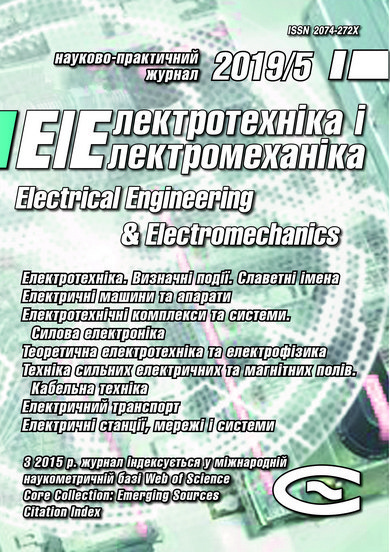PERFORMANCE COMPARISON OF MULTICELL SERIES AND NPC MULTILEVEL CONVERTERS FOR A STATCOM
DOI:
https://doi.org/10.20998/2074-272X.2019.5.10Keywords:
STATCOM, VSC, NPC converter, multicell series converter, modeling, controlAbstract
Abstract. In this paper, we present a comparative study of the performances of the multicells series and the Neutral-Point-Clamped (NPC) three-level converters used at synchronous static compensators (STATCOM) for the control of the voltage at a point of the network. The analysis consists on a mathematical modeling, a pulse width modulation (PWM) control algorithm application and a simulation using the Matlab Simulink environment. The simulation results obtained show that the STATCOM allows the regulation of the voltage at the point of common coupling (PCC) by acting the reactive energy that it can supply or absorb.References
Hingorani N.G, Gyugyi L. Understanding FACTS. Concepts and technology of Flexible AC Transmission Systems. IEEE Press,New York, 2000.
Kouro S., Malinowski M., Gopakumar K., Pou J., Franquelo L.G., Bin Wu., Rodriguez J., Pérez M.A., Leon J.I. Recent advances and industrial applications of multilevel converters. IEEE Transactions on Industrial Electronics, 2010, vol.57, no.8, pp. 2553-2580. doi: 10.1109/tie.2010.2049719.
Chetan E. Morkhade, Bhushan S. Rakhonde. Improvement in voltage profile using FACT device. International Journal of Scientific & Engineering Research, 2013, vol.4, iss.6, pp. 27-32.
Huang Z., Shengzhen Y., Hongyan Y., Xingming F. A control method for SVPWM-based STATCOM using active-reactive current decouple under dq coordinate system. International Conference and Exposition on Electrical and Power Engineering, EPE, Iasi, Romania, 2012, pp. 191-196. doi: 10.1109/icepe.2012.6463929.
Barik S.R, Nayak B., Dash S. A comparative analysis of three level VSC based multi-pulse STATCOM. International Journal of Engineering and Technology, 2014, vol.6, no.3, pp. 1550-1563.
Liu X., Lv J., Gao G., Chen Z., Chen S. A novel STATCOM based on diode-clamped modular multilevel converters. IEEE Transactions on Power Electronics, 2017, vol.32, no.8, pp. 5964-5977. doi: 10.1109/tpel.2016.2616495.
Malinowski M., Gopakumar K., Rodriguez J., Perez M.A. A survey on cascaded multilevel inverters. IEEE Transactions on Industrial Electronics, 2010, vol.57, no.7, pp. 2197-2206. doi: 10.1109/tie.2009.2030767.
Becker F. Contribution à la continuité de service des convertisseurs statiques multiniveaux. Phd de L'Université de Lorraine, 2017. (Fra).
Jones M., Satiawan I.N.W., Bodo N., Levi E. A dual five-phase space-vector modulation algorithm based on the decomposition method. IEEE Transactions on Industry Applications, 2012, vol.48, no.6, pp. 2110-2120. doi: 10.1109/tia.2012.2226422.
Baldés M. Etude d’un compensateur statique pour éoliennes à vitesse fixe à base de génératrice asynchrone à cage. Mémoire de Maitrise, Université du Québec, Canada, 2010. (Fra).
Berkoune K. Approche Mathématique pour la Modulation de Largeur d’Impulsion pour la conversion statique de l’´energie électrique: Application aux onduleurs multiniveaux. Doctorat de l’université de Toulouse, France, 2016. (Fra).
Crappe M. Exploitation des Réseaux Electriques avec L’électronique de Puissance. Lavoisier, 2006. (Fra).
Hanafi S., Fellah M.K., Guebli A., Chiali E. Commande du convertisseur multicellulaire série (7 cellules) par SVM avec régulation des tensions flottantes. The 2nd International Conference on Power Electronics and Electrical Drives, Oran,Algeria, 2012. (Fra).
Defay F., Llor A.-M., Fadel M. A predictive control with flying capacitor balancing of a multicell active power filter. IEEE Transactions on Industrial Electronics, 2008, vol.55, no.9, pp. 3212-3220. doi: 10.1109/tie.2008.927989.
Defay F., Llor A.M., Fadel M. A direct predictive control of shunt active power filters using multicell converter. 2007 European Conference on Power Electronics and Applications, 2007, pp. 1-9. doi: 10.1109/epe.2007.4417411.
Darshan P., Vineetha R., Jil S., Pratik P. A comparative study of three phase 2-level VSI with 3-level and 5-level diode clamped multilevel inverter. International Journal of Emerging Technology and Advanced Engineering, 2014, vol.4, no.4, pp. 708-713.
Wanchai S. Design and analysis three phase three level diode-clamped grid connected inverter. Energy Procedia, 2016, vol.89, pp. 130-136. doi: 10.1016/j.egypro.2016.05.019.
Murugesan K., Muthu R. Modeling and simulation of D-STATCOM for voltage regulations. 2011 1st International Conference on Electrical Energy Systems, 2011. doi: 10.1109/icees.2011.5727975.
Giroux P., Sybille G, Le-Huy H. Modeling and simulation of a distribution STATCOM using Simulink’s power system blockset. IECON’01. The 27th Annual Conference of the IEEE Industrial Electronics Society, 2001, pp. 990-994. doi: 10.1109/iecon.2001.975905.
Saha A., Ahmad S., Soma A.A., Chowdhury M.Z.A., Hossain A.A. Modelling and control of STATCOM to ensure stable power system operation. 2017 4th International Conference on Advances in Electrical Engineering (ICAEE), Sep. 2017, pp. 12-17. doi: 10.1109/icaee.2017.8255318.
Blažič B., Herman L., Božiček A., Papič I. Mathematical modeling and control algorithms of STATCOMs. Book chapter in Static Compensators (STATCOMs) in Power Systems, Dec. 2014, pp. 111-145. doi: 10.1007/978-981-287-281-4_4.
IEEE Standard 519-1992. IEEE Recommended Practices and Requirements for Harmonic Control in Electrical Power Systems. IEEE Inc., New York, 1992.
Downloads
Published
How to Cite
Issue
Section
License
Copyright (c) 2019 S. Belakehal, A. Djellad, R. Chenni

This work is licensed under a Creative Commons Attribution-NonCommercial 4.0 International License.
Authors who publish with this journal agree to the following terms:
1. Authors retain copyright and grant the journal right of first publication with the work simultaneously licensed under a Creative Commons Attribution License that allows others to share the work with an acknowledgement of the work's authorship and initial publication in this journal.
2. Authors are able to enter into separate, additional contractual arrangements for the non-exclusive distribution of the journal's published version of the work (e.g., post it to an institutional repository or publish it in a book), with an acknowledgement of its initial publication in this journal.
3. Authors are permitted and encouraged to post their work online (e.g., in institutional repositories or on their website) prior to and during the submission process, as it can lead to productive exchanges, as well as earlier and greater citation of published work.





